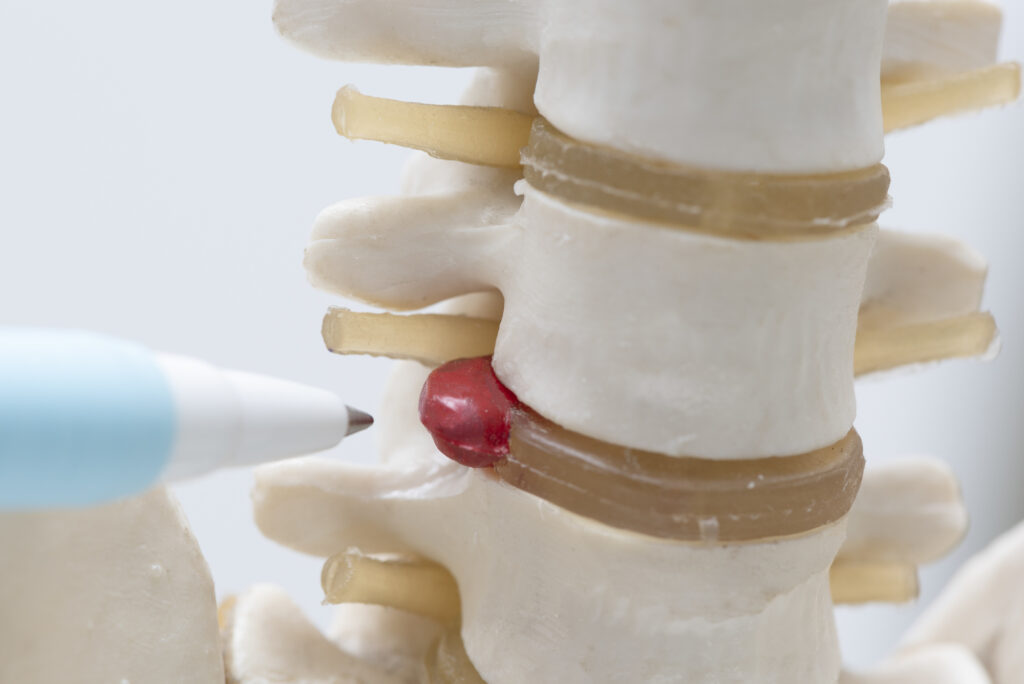Bulging vs Herniated Disc: What You Need to Know

You’re far from alone if you’re struggling with troublesome upper or lower back pain. Most of us will experience back pain, including common conditions like bulging or herniated discs. Research shows that up to 2% of the population will experience a herniated disc in any given year, and bulging discs are even more common.
Of course, your specific pain may leave you wondering about the difference between a bulging vs herniated disc. What separates the two conditions, and how can you tell which one you might have? Here’s what to know about these common spinal disc conditions.
Anatomy of a Spinal Disc
Before we dive into the details of a herniated disc vs a bulging disc, it’s essential to understand the anatomy of the spine.
You’re likely aware that your spine is separated into different segments called vertebrae.
Between your vertebrae are discs, which have a spongy, jelly-like layer of soft cartilage that helps your spine protect its flexibility. This soft inner core is the “nucleus pulposus.” A more rigid outer layer of cartilage protects this soft layer, the “annulus fibrosis.”
Though these layers act as cushions for the vertebrae, long-term pressure or short-term injuries can cause them to move and bulge, as we’ll discuss below.
What Is a Bulging Disc?
As we age, our discs begin to wear and tear. This can make the outer layer of our discs bulge into the spinal canal.
With poor posture causing a strain on your spine, you’re even more likely to experience a bulging disc. This can happen as the vertebrae put more pressure on one side of the disc, causing it to press outward in the opposite direction. A disc may bulge around its entire perimeter or along a small portion of it.
Often, you will also have a series of bulging discs rather than just one. It’s also worth noting that though the discs bulge, the outer layer of cartilage remains intact.
A bulging disc isn’t always a source of pain; in many people, it’s just part of the process of aging. However, these bulging discs can be painful in some people, especially when the bulging worsens over time. If these discs are in a position to compress a nerve root or cause inflammation, the pain can become even more severe.
What Is a Herniated Disc?
Herniated discs occur when a disc bulges too far, causing the outer layer of cartilage to crack. You may also hear herniated discs called “ruptured” or “slipped” discs.
A disc may become herniated once a bulging disc has worsened over time. It may also happen after an acute injury that causes damage to an already stressed spine.
Herniated discs are more likely to cause pain as they often affect a specific nerve root. Depending on the location and severity, you may have difficulty walking or notice numbness, tingling, or a loss of range of motion in your back or legs.
However, herniated discs don’t always cause pain as bulging discs. Some patients may not even realize they have a herniated disc until they have an MRI for an unrelated injury.
How to Tell the Difference Between a Bulging vs Herniated Disc
Both of these conditions are similar in many ways. They can happen anywhere along the spine, cause localized pain, and may result from poor posture or repetitive stress. However, there are a few ways to tell the difference between them.
If you’re trying to diagnose your condition on your own, you may notice a difference in the amount and location of the pain you experience. With a bulging disc, patients may notice pain creeping in over time and may not seek help until the pain has become severe. With a herniated disc, on the other hand, you’ll tend to see acute pain right away.
In addition, bulging discs are more likely to have happened due to repetitive spinal stress over a long period. Herniated discs are more likely to occur after an accident or injury.
Only with the help of a spine surgeon can you confirm whether or not you have a bulged or herniated disc. Though other types of imaging like X-rays can rule out other injuries, an MRI can help an expert diagnose the most likely cause of your pain.
Treating a Bulging or Herniated Disc
Pain from disc damage can be frustrating, but it may help to know that plenty of treatment options are available, especially if you’ve noticed the pain within the last six months.
In most cases, starting with conservative approaches can help you learn to self-manage your condition.
Physical therapy can help you strengthen the surrounding muscles to add a layer of protection to the area. Ice, heat, and massage therapy can also help with anti-inflammatory medication. For more severe cases, a steroid injection can help provide more immediate relief.
As a final step, surgery may be necessary to help you get lasting relief. Because every instance of disc herniation or bulging is different, these surgeries are always highly specialized and patient-focused, and most will use minimally invasive techniques.
Contact Us to Diagnose Your Pain
Struggling to identify the root cause of your pain can be stressful on your own. Though you might be able to guess your condition and its cause, only an expert can help you diagnose and treat your pain effectively.
That’s where we come in. Our team at New York City Spine has a wealth of experience helping patients heal from frustrating and painful spinal conditions, and we’d be happy to help you as well. Try using our tool to diagnose your pain today, or contact us with questions.
